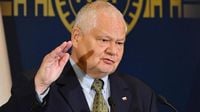In a significant shift following a two-day meeting, the National Bank of Poland (NBP) announced on May 8, 2025, its first interest rate cut in 19 months, lowering the reference rate by 0.5 percentage points to 5.25 percent. This decision, however, does not signal the beginning of a broader cycle of monetary easing, according to NBP President Adam Glapiński.
The Monetary Policy Council (RPP) emphasized that its sole focus remains on combating inflation, which has recently shown signs of decline. "This does not mean the beginning of a cycle of cuts," Glapiński reiterated, indicating that further adjustments may not occur until July 2025.
During the conference, Glapiński highlighted that the decision to reduce rates was based on macroeconomic data suggesting a more favorable inflation dynamic than previously anticipated. He noted that the inflation rate for the first quarter of 2025 was recorded at 4.9 percent, which is 0.5 percentage points lower than earlier projections from March. Preliminary data for April indicates a further decline in the Consumer Price Index (CPI) inflation to 4.2 percent, aided by the expiration of last year's VAT increase on food and lower fuel prices.
Despite these positive trends, Glapiński cautioned that the fight against high inflation is far from over. He pointed out that wages in the enterprise sector are still rising rapidly at 7.7 percent, and Poland's public finance deficit has reached 6.6 percent of GDP, the highest in the European Union alongside Romania. This situation remains pro-inflationary and complicates the efforts to stabilize prices.
Glapiński made it clear that the RPP does not consider the situation of borrowers when setting interest rates. "The only criterion for our decisions is the fight against inflation," he stated, dismissing concerns from borrowers and developers who have been lobbying for lower rates to boost housing demand. He expressed that such lobbying was misaligned with the NBP's foundational objectives.
Dr. Przemysław Kwiecień, chief economist at XTB, noted that the 50 basis point reduction is an unusual move for central banks, which typically prefer smaller adjustments of 25 basis points to monitor the impact of their decisions. This larger cut could be interpreted as an acknowledgment that disinflation in Poland is progressing faster than anticipated, allowing for a reduction in rates to support economic activity.
The market's reaction to the rate cut was muted, as the move had been anticipated by investors. The Polish złoty had already weakened slightly in response to Glapiński's earlier indications of potential rate cuts, with the euro rising from approximately 4.17 to 4.27 złoty following the announcement.
Looking ahead, Glapiński indicated that the RPP's future decisions will heavily depend on economic data, particularly the projections for inflation in July. He mentioned that while some members of the Council see the autumn as a more likely timeframe for discussing further rate adjustments, the June meeting is unlikely to result in any changes to monetary policy parameters.
As for the economic outlook, projections suggest that CPI inflation could decrease to 4.3 percent year-on-year in the second quarter of 2025 and further to 3.4 percent in the third quarter, before rebounding to 4.1 percent in the fourth quarter. This marks a downward revision from earlier estimates, which had predicted higher inflation rates.
In addition to discussing interest rates, Glapiński addressed the NBP's foreign currency reserves, revealing that Poland, with 509.3 tons of gold, has moved up to 12th place among central banks globally. The NBP's total reserve assets have now exceeded 242 billion USD, more than doubling over the past decade. The central bank has reportedly earned about 65-70 billion PLN from its gold purchases, although Glapiński clarified that this gain is considered "paper profit" since the bank does not plan to sell the gold.
As the NBP navigates these economic challenges, the focus remains firmly on inflation, with Glapiński stating, "The battle against high inflation is not over yet." He also highlighted the uncertainties surrounding energy prices and fiscal policy, which could complicate the path towards stable inflation.
Overall, the NBP's recent interest rate cut reflects a responsive approach to changing economic conditions, while maintaining a cautious stance on future monetary policy. Investors and borrowers alike will be watching closely for further developments as the NBP continues to address the complexities of Poland's economic landscape.

![W RPP nie patrzą na kredytobiorców. Prezes NBP o tym, co dalej z ratami [RELACJA]](https://thumbor.evrimagaci.org/mao5xe57VKKapCbVSmHVRutM9-M=/200x0/tpg%2Fsources%2F56689d8f-b410-4883-b3c0-e29016b8b019.jpeg)



